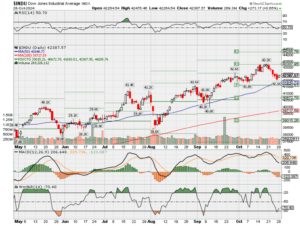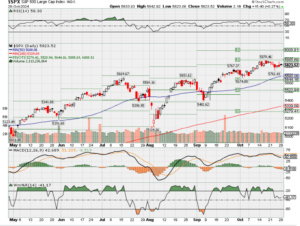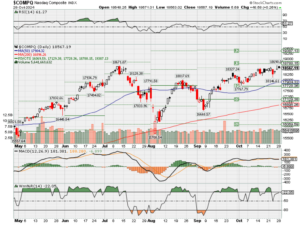HI Market View Commentary 10-28-2024
Busy week for the S&P 500 again – 16.12% of S&P 500 reporting, we run out of banks and move to industrials and technology for the next two weeks
What means is after hours market movements based on a handful of stocks
Very Important economic reports,
Christmas Rally looks intact so be ready to let stocks run !!!!
Earnings dates:
AAPL 10/31 AMC
BABA 11/21 BMO
BIDU 11/26 est
DG 12/05 est
DIS 11/14 BMO
F 10/28 AMC
GOOGL 10/29 AMC
JCI 11/06 AMC
META 10/30 AMC
MU 12/28 est
NVDA 11/2o est
O 11/04 AMC
SQ 11/07 AMC
TGT 11/20 BMO
UAA 11/11 est
V 10/29 AMC
https://www.briefing.com/the-big-picture
The Big Picture
Last Updated: 25-Oct-24 15:15 ET | Archive
Economic data full of surprises
Are you surprised by the U.S. economy’s resilience? There isn’t a uniform answer to that question.
Some would argue they aren’t surprised because there is so much fiscal and monetary policy stimulus in the system. Others would argue that they are surprised given that the Federal Reserve raised rates 11 times between March 2022 and July 2023 in its tightening campaign, that inflation pressures have not fully abated, and given the onerous interest rates on credit cards.
The objective fact of the matter is that the U.S. economy has managed to weather the Fed’s rate hikes. We will be reminded of that in the coming week when the Advance Q3 GDP report is released.
Casting Judgment
Real GDP increased 1.6% in the first quarter and 3.0% in the second quarter. The current Atlanta Fed GDPNow model estimate for real GDP growth in the third quarter is 3.3%. That is up from an initial forecast of 2.8% on July 26.
The forecast went as low as 2.0% on September 5, but since then a string of economic data has prompted a series of upward revisions.
The August employment report got things started, bumping the estimate to 2.5%. Following the September employment report, the estimate reached 3.3%. It got as high as 3.5% after the September New Home Sales Report before getting dialed back to 3.3% again in the wake of the September Durable Goods Orders Report.
It’s not a stretch to say that economists, in general, have expected economic activity to be softer than what the reports have been indicating. We can say that judging by the Citi Economic Surprise Index.
This index represents the sum of the difference between economists’ forecasts and the actual economic data. When the reading is above 0, the implication is that economic data is coming in better than expected. The opposite is true with a reading below 0.
To be clear, this isn’t a gauge of economic activity, but rather a gauge of how the data are comparing to forecasts. You could see a report, for example, that indicates retail sales were down 0.2%, but if the consensus estimate called for a decline of 0.5%, then that helps this gauge since the report was better than expected, yet it wouldn’t be considered a good report from a growth perspective.
What is clear in the chart above is that most of the data since late August has exceeded expectations. Fittingly, that fact lines up well with the progression of the Atlanta Fed GDPNow model estimate. It also lines up reasonably well with the trend in market rates. It’s not a perfect fit considering rates didn’t start going up steadily until after the Fed cut the target range for the fed funds rate by 50 basis points on September 18.
Both Are Valid
The better than expected economic data have taken a hard landing out of the market’s mind, forcing it to think that the economy may not have a landing at all — soft or otherwise. Consequently, that has led to a recalibration of the number of rate cuts the Federal Reserve might provide, which in turn has been a catalyst for short rates moving higher.
The back end of the yield curve has moved up in part because the growth outlook has improved, fueling concerns about inflation heating up again or at least not improving much further and driving some to think that the Fed’s neutral rate will end up higher than the Fed’s longer run estimate of 2.9%.
Arguably, another factor driving the rise in Treasury yields after the rate cut is the market’s worries about the monstrous national debt. We pointed out in our prior column that the debt stands at 124.3% of GDP and that the plans put forward by both presidential candidates are projected to add $3.5-7.5 trillion more in new debt over the next 10 years, according to the Committee for a Responsible Federal Budget.
There is a festering concern that the rise in Treasury yields could have more to do with the debt issue than it does with the improved economic view. We will humbly concede that both are valid positions and are making the Fed’s inclination to cut rates further more challenging and debatable.
A Cut Above the Rest
The U.S. economy is in a good position amongst advanced economies. The IMF certainly sees it that way, having recently released its World Economic Outlook Projections.
For 2024 the IMF sees real GDP growth for the U.S. increasing 2.8% at an annual rate versus just 0.8% for the euro area, 0.3% for Japan, 1.1% for the United Kingdom, and 1.3% for Canada.
The 2025 outlook projects some slowing, but the U.S. still comes out ahead of most with real GDP growth projected to increase 2.2% at annual rate versus 1.2% for the euro area, 1.1% for Japan, 1.5% for the United Kingdom, and 2.4% for Canada.
Separately, the IMF anticipates China’s real GDP will increase 4.8% at an annual rate in 2024 and 4.5% in 2025. India’s real GDP is projected to grow 7.0% at an annual rate in 2024 and 6.5% in 2025.
It is not an overstatement to say the U.S. economy remains a cut above other advanced economies, which is why it continues to attract foreign capital and why the stock market is handily outperforming stock markets in other advanced economies on a year-to-date basis.
What It All Means
The Federal Reserve is working to avoid the hard landing. Questions remain as to whether it can do that given the lag effect of prior rate hikes. The economic data, however, remains on the Fed’s side for the most part, which is exactly what the stock market wants to see.
That preference is apparent in the fact that the S&P 500 and Nasdaq Composite have held near record highs even as market rates have moved up appreciably since the September 18 rate cut. The relative strength implies that the stock market is operating predominately with a belief that the U.S. growth outlook is intact, which in turn makes it believe the earnings growth outlook is intact.
That view makes it all the more important for the economic data to continue to surprise in a good way.
Where will our markets end this week?
Lower
DJIA – Bearish
SPX – Bullish
COMP – Bullish
Where Will the SPX end November 2024?
10-28-2024 ????
Earnings:
Mon: FFIV, FLS, RMBS, VFC, WM, F
Tues: BP, GLW, DHI, JBLUE, MCD, PYPL, PFE, RCL, EA, FSLR, GOOGL, CB, V,
Wed: CAT, LLY, GRMN, HES, HUM, IMAX, KHC, WING, AMGN, CLX, EBAY, HUBG, GMG, MSFT, ROKU, SBUX, TWLO, META
Thur: MO, BUD, BMY, LNG, CMS, COP, EL, GWW, H, IP, MA, UBER, WEN, AMZN, LOCO, INTC, JNPR, SKYW,X AAPL,
Fri: CAH, CVX, D, XOM
Econ Reports:
Mon:
Tue FHFA Housing Price Index, S&P Case Shiller, Consumer Confidence
Wed: MBA, ADP Employment, GDP, GDP Deflator, Pending Home Sales,
Thur: Initial Claims, Continuing Claims, PCE Prices, PCE Core, Personal Spending, Personal Income, Employment Cost Index,
Fri: Average Workweek, Non-Farm Payroll, Private Payroll, Unemployment Rate, Hourly Earnings, Construction Spending, ISM Manufacturing
How am I looking to trade?
Protection thru earnings and leaving some on for the election next week
www.myhurleyinvestment.com = Blogsite
info@hurleyinvestments.com = Email
Questions???
https://www.cnbc.com/2024/10/25/jeff-bezos-killed-washington-post-endorsement-of-kamala-harris-.html
Jeff Bezos killed Washington Post endorsement of Kamala Harris, paper reports
Published Fri, Oct 25 20241:44 PM EDTUpdated Sat, Oct 26 20244:04 PM EDT
Key Points
- The Washington Post said it will not endorse a candidate in the presidential election for the first time in decades.
- The newspaper ran an article by two staff reporters saying that editorial page staffers had drafted an endorsement of Kamala Harris over Donald Trump in the election.
- “The decision not to publish was made by The Post’s owner — Amazon founder Jeff Bezos,” the article said.
- In a 2019 lawsuit, Amazon claimed it lost a $10 billion Pentagon cloud computing contract to Microsoft because Trump used “improper pressure … to harm his perceived political enemy” Bezos.
In this article
The Washington Post said Friday that it will not endorse a candidate in the presidential election this year — or ever again — breaking decades of tradition and sparking immediate criticism of the decision.
But the newspaper also published an article by two staff reporters revealing that editorial page staffers had drafted an endorsement of Democratic nominee Kamala Harris over GOP nominee Donald Trump in the election.
“The decision not to publish was made by The Post’s owner — Amazon founder Jeff Bezos,” the article said, citing two sources briefed on the events.
Trump, while president, had been critical of the billionaire Bezos and the Post, which he purchased in 2013.
The newspaper in 2016 and again in 2020 endorsed Trump’s election opponents, Hillary Clinton and President Joe Biden, in editorials that condemned the Republican in blunt terms.
In a 2019 lawsuit, Amazon claimed it had lost a $10 billion cloud computing contract with the Pentagon to Microsoft because Trump had used “improper pressure … to harm his perceived political enemy” Bezos.
The Post since 1976 had regularly endorsed candidates for president, except for the 1988 race. All those endorsements had been for Democrats.
In a statement to CNBC, when asked about Bezos’ purported role in killing the endorsement, Post chief communications officer Kathy Baird said, “This was a Washington Post decision to not endorse, and I would refer you to the publisher’s statement in full.”
On Saturday, Post publisher Will Lewis issued a statement denying that Bezos played a role in killing the planned endorsement.
“Reporting around the role of The Washington Post owner and the decision not to publish a presidential endorsement has been inaccurate,” Lewis said in the statement. “He was not sent, did not read and did not opine on any draft. As Publisher, I do not believe in presidential endorsements. We are an independent newspaper and should support our readers’ ability to make up their own minds.”
The Post on Friday evening published a third article, signed by opinion columnists for the newspaper, who said, “The Washington Post’s decision not to make an endorsement in the presidential campaign is a terrible mistake.”
“It represents an abandonment of the fundamental editorial convictions of the newspaper that we love, and for which we have worked a combined 218 years,” the column said. “This is a moment for the institution to be making clear its commitment to democratic values, the rule of law and international alliances, and the threat that Donald Trump poses to them — the precise points The Post made in endorsing Trump’s opponents in 2016 and 2020.”
CNBC has requested comment from Amazon, where Bezos remains the largest shareholder.
Lewis, in an article published online explaining the decision, wrote, “The Washington Post will not be making an endorsement of a presidential candidate in this election. Nor in any future presidential election.”
“We are returning to our roots of not endorsing presidential candidates,” Lewis wrote.
“We recognize that this will be read in a range of ways, including as a tacit endorsement of one candidate, or as a condemnation of another, or as an abdication of responsibility,” he wrote.
“That is inevitable. We don’t see it that way. We see it as consistent with the values The Post has always stood for and what we hope for in a leader: character and courage in service to the American ethic, veneration for the rule of law, and respect for human freedom in all its aspects.”
Seven of the 13 paragraphs of Lewis’ article either quoted at length or referred to Post Editorial Board statements in 1960 and 1972 explaining the paper’s rationale for not endorsing presidential candidates in those years, which included its identity as “an independent newspaper.”
Lewis noted that the paper had endorsed Jimmy Carter in 1976 “for understandable reasons at the times” — which he did not identify.
“But we had it right before that, and this is what we are going back to,” Lewis wrote.
“Our job as the newspaper of the capital city of the most important country in the world is to be independent,” he wrote. “And that is what we are and will be.”
Post editor-at-large Robert Kagan, a member of the paper’s opinions section, resigned following the decision, multiple news outlets reported.
More than 10,000 reader comments were posted on Lewis’ article, many of them blasting the Post for its decision and saying they were canceling their subscriptions.
“The most consequential election in our country, a choice between Fascism and Democracy, and you sit out? Cowards. Unethical, fearful cowards,” wrote one comment. “Oh, and by the way, I’m canceling my subscription, because you are putting business ahead of ethics and morals.”
The announcement came days after Mariel Garza, the head of The Los Angeles Times’ editorial board, resigned in protest after that paper’s owner, Patrick Soon-Shiong, decided against running a presidential endorsement.
“I am resigning because I want to make it clear that I am not okay with us being silent,” Garza told the Columbia Journalism Review. “In dangerous times, honest people need to stand up. This is how I’m standing up.”
Soon-Shiong, like Bezos, is a billionaire.
Marty Baron, the former editor of The Washington Post, called that paper’s decision “cowardice, with democracy as its casualty.”
″@realdonaldtrump will see this as an invitation to further intimidate owner @jeffbezos (and others),” Baron wrote. “Disturbing spinelessness at an institution famed for courage.”
The Washington Post Guild, the union that represents the newspaper’s staff, in a statement posted on the social media site X said it was “deeply concerned that The Washington Post — an American news institution in the nation’s capital — would make a decision to no longer endorse presidential candidates, especially a mere 11 days ahead of an immensely consequential election.”
“The message from our chief executive, Will Lewis — not from the Editorial Board itself — makes us concerned that management interfered with the work of our members in Editorial,” the Guild said in the statement, which noted the paper’s reporting about Bezos’ role in the decision.
“We are already seeing cancellations from once loyal readers,” the Guild said. “This decision undercuts the work of our members at a time when we should be building our readers’ trust, not losing it.”
Former Post reporters Bob Woodward and Carl Bernstein, whose stories about the Watergate break-in during the Nixon administration won the newspaper a Pulitzer Prize for Public Service, in a statement said, “We respect the traditional independence of the editorial page, but this decision 11 days out from the 2024 presidential election ignores the Washington Post’s own overwhelming reportorial evidence on the threat Donald Trump poses to democracy.”
“Under Jeff Bezos’s ownership, the Washington Post’s news operation has used its abundant resources to rigorously investigate the danger and damage a second Trump presidency could cause to the future of American democracy and that makes this decision even more surprising and disappointing, especially this late in the electoral process,” Woodward and Bernstein said.
Post columnist Karen Attiah, in a post on the social media site Threads, wrote, “Today has been an absolute stab in the back.”
“What an insult to those of us who have literally put our careers and lives on the line to call out threats to human rights and democracy,” Attiah wrote.
Rep. Ted Lieu, a Democrat from California, in his own tweet on the news wrote, “The first step towards fascism is when the free press cowers in fear.”
Trump in August told Fox Business News that Bezos called him after the Republican narrowly escaped an assassination attempt in July at a campaign rally in western Pennsylvania.
“He was very nice even though he owns The Washington Post,” Trump said of Bezos.
Bezos last posted on X on July 13, hours after the assassination attempt.
“Our former President showed tremendous grace and courage under literal fire tonight,” Bezos wrote in that tweet. “So thankful for his safety and so sad for the victims and their families.”
Trump on Friday met in Austin, Texas, with executives from the Bezos-owned space exploration company Blue Origin, among them CEO David Limp, the Associated Press reported
Here’s what changed in the new Fed statement
Published Wed, Sep 18 20242:04 PM EDTUpdated Wed, Sep 18 20242:47 PM EDT
Jesse Pound@/in/jesse-pound@jesserpound
ShareShare Article via FacebookShare Article via TwitterShare Article via LinkedInShare Article via Email
This is a comparison of Wednesday’s Federal Open Market Committee statement with the one issued after the Fed’s previous policymaking meeting in July.
Text removed from the July statement is in red with a horizontal line through the middle.
Text appearing for the first time in the new statement is in red and underlined.
Black text appears in both statements.
Follow along with continuing Fed coverage and Chair Jerome Powell’s news conference here.
Goldman forecasts just a 3% S&P 500 annual return the next 10 years, down from 13% the last decade
Published Mon, Oct 21 20247:03 AM EDTUpdated Mon, Oct 21 20249:29 AM EDT
The S&P 500 will serve up a minuscule return over the next decade that falls far short of the booming gains from the last decade, forecasts Goldman Sachs’ equity strategy team, citing today’s high concentration in just a few stocks and a lofty starting valuation.
The broad market index will produce an annualized nominal total return of just 3% the next 10 years, according to the team led by David Kostin, which would rank in just the 7th percentile of 10-year returns since 1930. The S&P 500 returned 13% annually the last 10 years, above the long-term average of 11%, according to Goldman.
Goldman’s bearish long-term forecast comes just as the S&P 500 has entered the third year of a bull market, garnering a 27% annual total return the last two years. Investors are extremely bullish on the notion the economy weathered an inflation surge and will now have several Federal Reserve rate cuts at its back.
But Goldman’s team is worried that these returns have been driven by just a few stocks — namely “the Magnificent Seven” led by the likes of Nvidia and Alphabet — and that a few stocks can only keep up their dominance for so long.
“The intuition for why concentration matters for long-term returns relates to growth in addition to valuation,” stated the strategy paper from the end of last week. “Our historical analyses show that it is extremely difficult for any firm to maintain high levels of sales growth and profit margins over sustained periods of time.”
Historically high valuation
Along with concentration, Goldman looks at four other market variables for its model: valuation, economic fundamentals, interest rates and profitability.
On valuation, the firm uses a cyclically adjusted price-earnings ratio, otherwise known as “CAPE,” with the notion that the higher the starting valuation, the lower the future returns. The current CAPE ratio is 38 times, which is in the 97th percentile, said Goldman.
“The current high level of equity valuations is a key reason our 10-year forward return forecast sits at the lower end of the historical distribution,” said the note.
Along with the baseline forecast, Goldman’s model gives a range of annual return possibilities from plus 7% annually to negative 1% annually.
The firm said the forecast suggests a 72% probability that stocks trail bonds the next decade. Goldman said the equal-weight S&P 500 would produce higher returns than the regular benchmark because of the concentration risk. The Invesco S&P 500 Equal Weight ETF (RSP) tracks an equally distributed version of the index.
Goldman not alone
JPMorgan is similarly pessimistic over the long term, though not as much so as Goldman. JPMorgan forecast last month the S&P 500 annual return for the next decade would be about 6%. JPMorgan cited high valuation like Goldman, along with higher-than-average inflation tied to large fiscal spending. Persistent inflation could weight on market multiples, JPMorgan said.
Goldman researched the 10-year equity return assumptions of 21 asset managers and computed that they are predicting, on average, U.S. equity returns of 6% for the next decade, double the Goldman forecast.
The firm calculated that the average public pension plan is assuming a 10-year annualized return for its full portfolio (not just stocks) of 6.9%.
“If realized long-term US equity returns are near our baseline forecast, then other asset classes would have to post extremely strong performance in order for funds to meet their long-term portfolio return assumptions,” wrote the Goldman strategists.




HI Financial Services Mid-Week 06-24-2014